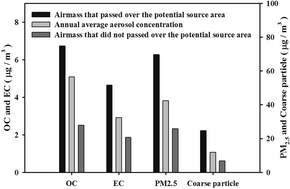The contributions of long range transported aerosol in East Asia to carbonaceous aerosol and particulate matter (PM) concentrations in Seoul, Korea were estimated with potential source contribution function (PSCF) calculations. Carbonaceous aerosol (organic carbon (OC) and elemental carbon (EC)), PM2.5, and PM10 concentrations were measured from April 2007 to March 2008 in Seoul, Korea. The PSCF and concentration weighted trajectory (CWT) receptor models were used to identify the spatial source distributions of OC, EC, PM2.5, and coarse particles. Heavily industrialized areas in Northeast China such as Harbin and Changchun and East China including the Pearl River Delta region, the Yangtze River Delta region, and the Beijing–Tianjin region were identified as high OC, EC and PM2.5 source areas. The conditional PSCF analysis was introduced so as to distinguish the influence of aerosol transported from heavily polluted source areas on a receptor site from that transported from relatively clean areas. The source contributions estimated using the conditional PSCF analysis account for not only the aerosol concentrations of long range transported aerosols but also the number of transport days effective on the measurement site. Based on the proposed algorithm, the condition of airmass pathways was classified into two types: one condition where airmass passed over the source region (PS) and another condition where airmass did not pass over the source region (NPS). For most of the seasons during the measurement period, 249.5–366.2% higher OC, EC, PM2.5, and coarse particle concentrations were observed at the measurement site under PS conditions than under NPS conditions. Seasonal variations in the concentrations of OC, EC, PM2.5, and coarse particles under PS, NPS, and background aerosol conditions were quantified. The contributions of long range transported aerosols on the OC, EC, PM2.5, and coarse particle concentrations during several Asian dust events were also estimated. We also investigated the performance of the PSCF results obtained from combining highly time resolved measurement data and backward trajectory calculations via comparison with those from data in low resolutions. Reduced tailing effects and the larger coverage over the area of interest were observed in the PSCF results obtained from using the highly time resolved data and trajectories.


 Please wait while we load your content...
Please wait while we load your content...